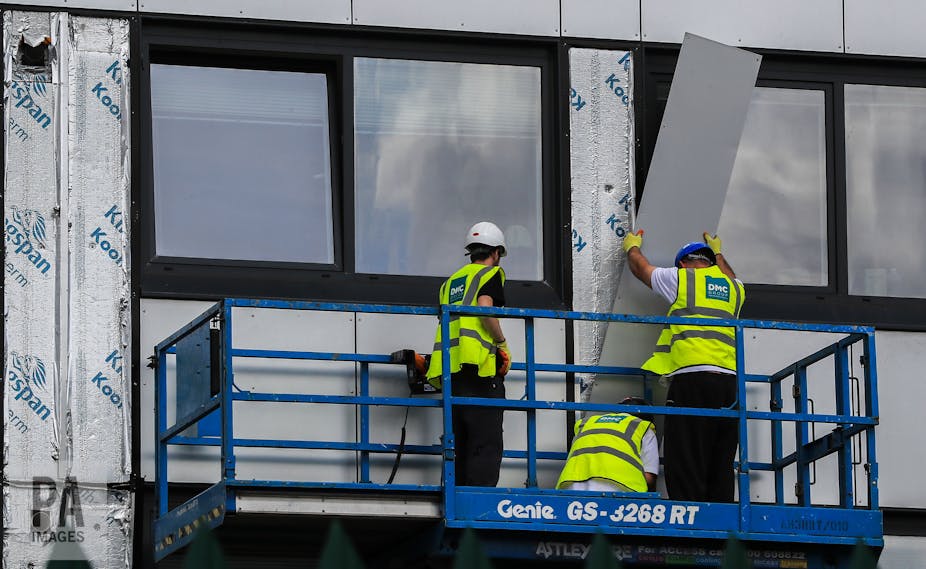Camden Council has been evacuating residents from four tower blocks in north London in response to concerns over their fire safety, and a total of 120 local authority and housing association-owned tower blocks across England have now been shown to have cladding that is “dangerously combustible”. Tests are continuing.
A concerted effort is now being made to keep residents safe. The prime minister, Theresa May, has called the immediate response to the Grenfell fire a “failure of the state, local and national”. It is right the current action is being taken but it is necessarily rushed and reactive. So it’s time to start looking more generally at the current approach to the governance of these kinds of built environment issues in Britain.
Building regulations
The exact causes, circumstances and response to the fire will be subject to a judge-led inquiry. It is clear that building regulations will form part of that inquiry, for example whether the cladding and insulation on the exterior of Grenfell Tower complied with regulations – which would suggest that regulations may be at fault. If the cladding is found to have failed to comply with regulations, it would suggest problems in contracting and inspection regimes. Either answer suggests that further failings of the state may emerge.
I am currently engaged in research on the impact of deregulating planning controls governing the change of use of office buildings to residential use in England and have seen examples of very low-quality housing being delivered through this. Deregulation has long-term consequences in both built and natural environments. And the consequences of poor decisions or regulation can take years to emerge.
Capacity issues
Austerity, deregulation and privatisation are important elements in the tragic story of the Grenfell fire. The Department for Communities and Local Government (DCLG), responsible for planning and building regulations in England, lost more than 35% of its staff (the biggest percentage reduction of any central government department) between 2010 and 2015. The National Audit Office expressed concern that such cuts might “damage the delivery of public services”. The local council, Kensington and Chelsea, lost 24% of its staff between 2008 and 2016.
Across the UK, local government has lost one-third of its funding since 2010. The biggest hit departments have often been those responsible for planning and building control.
At the same time, the former coalition and Conservative governments promised a “bonfire of red tape” with a “one-in-two-out” rule governing new regulation. And the delivery of local services now involves a complex web of public and private companies. Building regulation enforcement is partially privatised to a system of “approved inspectors”.
This creeping privatisation is an issue. It is interesting that the 2016 Housing and Planning Act contained proposals to allow a similar “alternative provider” approach to planning applications as already exists for building regulations in England. It is not hyperbolic to wonder if there is a conflict of interest in allowing a system whereby a private developer can chose to send their planning application to an approved private consultant of their choosing to process rather than the local authority. This slow movement towards privatisation of regulation in this area should be halted.
All of these factors combine to weaken the state and its abilities to keep people safe. Looking forward, important questions need to be asked in response to all three.

The state needs labour in order to actually function. If there aren’t people in central government to proactively revise and update regulations and in local government to effectively enforce them, that is a state failure. It is surprising that the part of the building regulations dealing with fire safety haven’t been updated since a coroner’s inquest called for them to be revised in 2013. There is a sense that there was also a lack of response to other cladding-related fires in other countries.
It seems likely that there will now be changes to building regulations – which are complex – but future updates should be done through having sufficient staff to scan the horizon for potential dangers and keep on top of developing good regulation rather than having to wait for a catastrophe to happen.
Regulation is not a dirty word – and it is vital for keeping people safe and allowing us to enjoy a reasonable quality of life. There have been calls to use Brexit as an opportunity for further deregulation, including around building standards and fire safety, and attempts to resist regulation that would require sprinklers in high-rise buildings.
It seems too much to hope that the complete mindset around regulation will change, but perhaps there might at least be a pause on further deregulation when it comes to buildings in the UK. There should also be some thought about whether certain parts of the building regulations should apply retrospectively to older buildings rather than just applying higher standards to new construction only.
The UK is not a poor country. That 79 people can die in a fire in its richest city is deeply distressing, but unfortunately this tragedy appears to have been avoidable. Looking ahead, we need a greater appreciation of the role of those who uphold standards in the built environment, and to ensure that both the central and local governments have the proper tools to keep buildings and those who live, work and play in them safe.

